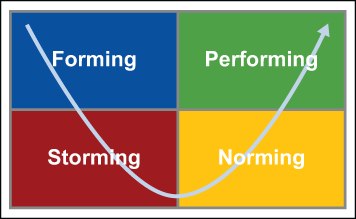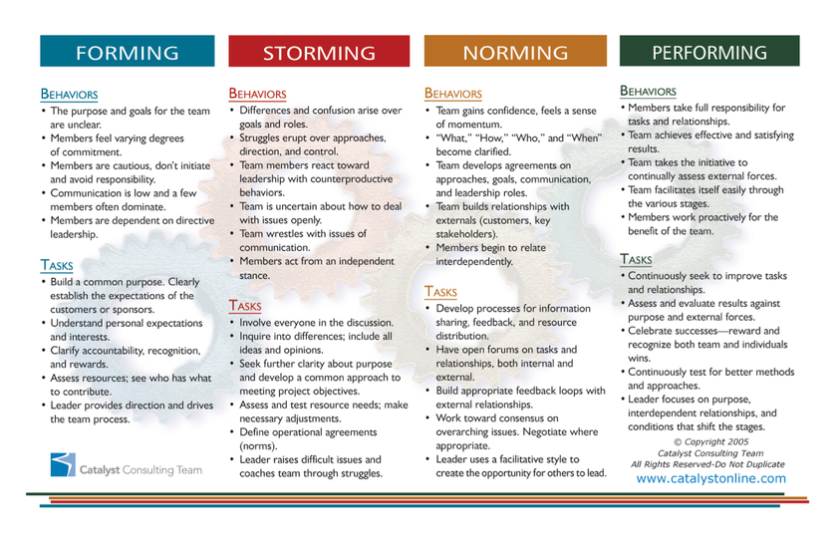W1_Mubarak_TuckMan_Assessment
- Problem Definition.
Team “OOCEP_PMP 2016” has been established as part of OOCEP Project management program 2016. It is important to know at which stage the team is progressing so that we know the best approach to help the team perform and function in order to meet the goals and align the purposes of the project and help the team maximize its process and its productivity. Tuckman’s assessment will be used in determining the team development stage, behavior of this teamwork and leadership style.
- Methodology and Results:
A questionnaire was used by the team to answer 32 questions and to help rank what stage we think the team was on. A total of 10 samples gave us the below results.
| Forming | Storming | Norming | Performing | |
| Min | 22 | 17 | 25 | 28 |
| Most Likely | 27 | 21 | 29 | 33 |
| Max | 28 | 26 | 32 | 37 |
| Mean | 26 | 21 | 29 | 33 |
| St. Dev | 1 | 2 | 1 | 2 |
| Variance | 1 | 2 | 1 | 2 |
| P 90 (Z=1.29) | 35 | 30 | 39 | 45 |
Table 1.
- Development of the feasible alternatives
In 1965, Bruce Tuckman published four stages of Team Development i.e. Forming, Storming, Norming and Performing to explain the team’s maturity and ability, relationships establish and the leader leadership style.
Forming is the set-up phase where the team is founded. There is no shared history and no work experience together.
Storming is the phase where the team attempts to work together but usually experiences conflicts. At this stage it becomes clear that the team lacks the tools or even agreement on what they want to accomplish together (goals).
Norming is an important stage for learning, planning and decision-making together. The team agrees on a shared goal (or goals), roles and responsibilities.
Performing is the team’s productive stage, where work tasks are accomplished. The team’s efficiency and efficacy improve (Drucker, 1985). The team’s shared success builds a feeling of commitment and trust.
Adjourning is the team’s completion stage, where work tasks are completed and the team is disassembled. The motivation is decline as uncertainty of the future start to set in and this is the best time to introduce new project on re-forming the stage of team development.
Figure 1.The Tuckman Stages of Team Development1
- Possible solution / alternative
The alternative solution that OOCEP PMI 2016 team will be one of the four phases; Forming phase, Storming Phase, Norming Phase or Performing Phase.
- Selection of Criteria
Based on the result shown on Table 1 that OOCEP_PMI_2016 team is in Performing stage using Delphi technique with P90.
- Analysis and Comparison of the Alternative
By studying and analyzing of the results shows in table 1, the results point to that the team currently in the performing stage this shows that the team is aware of what they have to do and why it is doing and what it is doing .However, delegation is crucial for the team at this stage in order to accelerate the team dynamic.
- Selection of the Preferred Alternative.
The selected of the preferred alternative based on the result above required is a delegating type of leadership in which the leader is involve in decisions; however, the process and responsibility has been passed to the individual or group.
- Performance Monitoring and the Post Evaluation of Result.
As the team OOCEP_PMI_2016 came from the same company “OOCEP” where they knew each other and have worked with each other’s. It has accelerated the phase movement from Forming to end up in performing. Essential alignment on this project has taken this team through the Forming, Storming, Norming but it been short period of time before they reach the performing phase due to earlier work experience with each other.
After evaluation of results, we should know clearly why it is doing what it is doing it can be include that the team formed well together as a team keep in a consideration achieving team goals and objectives .Hence, the delegation leadership style is the appropriate style for the team at this progress stage. An outlooks point of view expected form the team to work in independence where minimum supervision is required from the management.
References:
- Forming, Storming, Norming, and Performing: Understanding the Stages of Team Formation. (n.d.). Forming, Storming, Norming, and Performing. Retrieved June 4, 2014, from http://www.mindtools.com/pages/article/newLDR_86.htm
- com Stages of Team Development (Tuckman) Retrieved from:http://www.12manage.com/methods_tuckman_stages_team_development.html
- org. (2012). Survey: what stage is Your Team In?. Retrieved fromhttp://www.cscaweb.org/EMS/sector_team/support_files/tools_for_the_team/tool_stage.pdf
- Related materials. (n.d.). situational leadership analysis. Retrieved June 4, 2014, fromhttp://www.businessballs.com/slanalysis.htm



